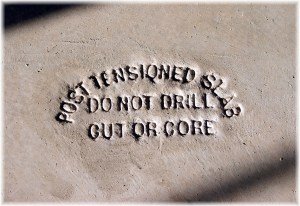Post Tension Slab on Grade
Post Tension Slab on Grade
Whether they’re constructing crack-free tennis courts, smooth parking garage surfaces, or a stable foundation for someone’s new home, builders can count on post tension slabs to help reduce the risks associated with concrete contraction and expansion and to ensure the strength of their structures. For these reasons and others, post-tension slabs are a cost-effective alternative to conventional concrete slab foundations.
Conventional slabs don’t allow for much movement in the soil they rest upon, which is why they are susceptible to the swelling and shrinking caused by seasonal changes in weather. The clay soils common in Southern California, Arizona, and Texas are particularly expansive, and the movement they cause is often enough to undermine a conventional slab foundation. Post tension slabs reduce these issues by allowing the builders to construct slabs that can move with the soil, which also helps to increase the stability of these structures.
In order to properly use a post-tension slab, it must be constructed by experienced professionals who understand the process and can work with it. When a slab is being built with this system, steel cables called tendons are placed inside the concrete and are then stressed before the concrete has to bear service loads. This stressing, or prestressing, is what sets a post-tension slab apart from a conventional concrete slab foundation and is what makes this type of slab more resilient to the varying movements in the soil.
When a home is constructed with a post-tension slab, you won’t be able to see any evidence of the tendons that are within it unless you know what you’re looking for. The tendons are usually buried in plastic sleeves and look a little like thick rebar. However, if you want to see proof of the tendons in a slab that has already been built, you can walk around the perimeter of the house and look for small circles (about one and a half inches wide) that have been patched up, as these are what indicate the presence of the tendons.
In addition to these signs, a homeowner can also spot a post-tension slab by checking the foundations for signs of stress. If there are no signs, you can contact the builder to learn more about the slab’s construction or you can check the home’s blueprints for information on where the tendons are. If a sign is present, homeowners are advised not to cut or core the slab for safety reasons, as doing so can cause the steel cable to be damaged and potentially injure people who work on or near the building. Gaje Contracting is proud to have years of experience protecting post-tension slabs from corrosion factors and damage, ensuring that the cables remain intact and that the structures they support continue to be strong and safe for residents and pedestrians alike. Contact us today to find out more about our services. We can protect your slab from corrosive elements and keep it looking brand-new.


